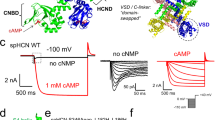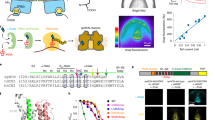Abstract
Hyperpolarization-activated cyclic-nucleotide-gated (HCN) ion channels are found in rhythmically firing cells in the brain and in the heart1, where the cation current through HCN channels (called Ih or If) causes these cells to fire repeatedly2. These channels are also found in non-pacing cells, where they control resting membrane properties, modulate synaptic transmission, mediate long-term potentiation, and limit extreme hyperpolarizations3,4,5,6,7. HCN channels share sequence motifs with depolarization-activated potassium (Kv) channels, such as the fourth transmembrane segment S48,9. S4 is the main voltage sensor of Kv channels, in which transmembrane movement of S4 charges triggers the opening of the activation gate10,11,12,13,14,15,16,17. Here, using cysteine accessibility methods10,11,12, we investigate whether S4 moves in an HCN channel. We show that S4 movement is conserved between Kv and HCN channels, which indicates that S4 is also the voltage sensor in HCN channels. Our results suggest that a conserved voltage-sensing mechanism operates in the oppositely voltage-gated Kv and HCN channels, but that there are different coupling mechanisms between the voltage sensor and activation gate in the two different channels.
This is a preview of subscription content, access via your institution
Access options
Subscribe to this journal
Receive 51 print issues and online access
$199.00 per year
only $3.90 per issue
Buy this article
- Purchase on Springer Link
- Instant access to full article PDF
Prices may be subject to local taxes which are calculated during checkout




Similar content being viewed by others
References
Santoro, B. & Tibbs, G. R. The HCN gene family: molecular basis of the hyperpolarization-activated pacemaker channels. Ann. NY Acad. Sci. 868, 741–764 (1999)
DiFrancesco, D. Pacemaker mechanisms in cardiac tissue. Annu. Rev. Physiol. 55, 455–472 (1993)
Pape, H. C. Queer current and pacemaker: the hyperpolarization-activated cation current in neurons. Annu. Rev. Physiol. 58, 299–327 (1996)
Magee, J. C. Dendritic hyperpolarization-activated currents modify the integrative properties of hippocampal CA1 pyramidal neurons. J. Neurosci. 18, 7613–7624 (1998)
Magee, J. C. & Carruth, M. Dendritic voltage-gated ion channels regulate the action potential firing mode of hippocampal CA1 pyramidal neurons. J. Neurophysiol. 82, 1895–1901 (1999)
Beaumont, V. & Zucker, R. S. Enhancement of synaptic transmission by cyclic AMP modulation of presynaptic Ih channels. Nature Neurosci. 3, 133–141 (2000)
Mellor, J., Nicoll, R. A. & Schmitz, D. Mediation of hippocampal mossy fiber long-term potentiation by presynaptic Ih channels. Science 295, 143–147 (2002)
Kaupp, U. B. & Seifert, R. Molecular diversity of pacemaker ion channels. Annu. Rev. Physiol. 63, 235–257 (2001)
Gauss, R., Seifert, R. & Kaupp, U. B. Molecular identification of a hyperpolarization-activated channel in sea urchin sperm. Nature 393, 583–587 (1998)
Yang, N. & Horn, R. Evidence for voltage-dependent S4 movement in sodium channels. Neuron 15, 213–218 (1995)
Larsson, H. P., Baker, O. S., Dhillon, D. S. & Isacoff, E. Y. Transmembrane movement of the shaker K+ channel S4. Neuron 16, 387–397 (1996)
Yang, N., George, A. L. Jr & Horn, R. Molecular basis of charge movement in voltage-gated sodium channels. Neuron 16, 113–122 (1996)
Aggarwal, S. K. & MacKinnon, R. Contribution of the S4 segment to gating charge in the Shaker K+ channel. Neuron 16, 1169–1177 (1996)
Seoh, S. A., Sigg, D., Papazian, D. M. & Bezanilla, F. Voltage-sensing residues in the S2 and S4 segments of the Shaker K+ channel. Neuron 16, 1159–1167 (1996)
Yusaf, S. P., Wray, D. & Sivaprasadarao, A. Measurement of the movement of the S4 segment during the activation of a voltage-gated potassium channel. Pflugers Arch. 433, 91–97 (1996)
Mannuzzu, L. M., Moronne, M. M. & Isacoff, E. Y. Direct physical measure of conformational rearrangement underlying potassium channel gating. Science 271, 213–216 (1996)
Baker, O. S., Larsson, H. P., Mannuzzu, L. M. & Isacoff, E. Y. Three transmembrane conformations and sequence-dependent displacement of the S4 domain in shaker K+ channel gating. Neuron 20, 1283–1294 (1998)
Vaca, L. et al. Mutations in the S4 domain of a pacemaker channel alter its voltage dependence. FEBS Lett. 479, 35–40 (2000)
Chen, J., Mitcheson, J. S., Lin, M. & Sanguinetti, M. C. Functional roles of charged residues in the putative voltage sensor of the HCN2 pacemaker channel. J. Biol. Chem. 275, 36465–36471 (2000)
Shin, K., Rothberg, B. & Yellen, G. Blocker state dependence and trapping in hyperpolarization-activated cation channels. Evidence for an intracellular activation gate. J. Gen. Physiol. 117, 91–102 (2001)
Horn, R., Ding, S. & Gruber, H. J. Immobilizing the moving parts of voltage-gated ion channels. J. Gen. Physiol. 116, 461–476 (2000)
Rothberg, B. S., Shin, K. S., Phale, P. S. & Yellen, G. Voltage-controlled gating at the intracellular entrance to a hyperpolarization-activated cation channel. J. Gen. Physiol. 119, 83–91 (2002)
Liu, Y., Holmgren, M., Jurman, M. E. & Yellen, G. Gated access to the pore of a voltage-dependent K+ channel. Neuron 19, 175–184 (1997)
del Camino, D., Holmgren, M., Liu, Y. & Yellen, G. Blocker protection in the pore of a voltage-gated K+ channel and its structural implications. Nature 403, 321–325 (2000)
Larsson, H. P. & Elinder, F. A conserved glutamate is important for slow inactivation in K+ channels. Neuron 27, 573–583 (2000)
Allende, C. C., Bravo, R. & Allende, J. E. Comparison of in vivo and in vitro properties of cyclic adenosine 3′:5′-monophosphate phosphodiesterase of amphibian oocytes. J. Biol. Chem. 252, 4662–4666 (1977)
Maller, J. L., Butcher, F. R. & Krebs, E. G. Early effect of progesterone on levels of cyclic adenosine 3′:5′-monophosphate in Xenopus oocytes. J. Biol. Chem. 254, 579–582 (1979)
Taglialatela, M., Toro, L. & Stefani, E. Novel voltage clamp to record small, fast currents from ion channels expressed in Xenopus oocytes. Biophys. J. 61, 78–82 (1992)
Keynes, R. D. & Elinder, F. The screw-helical voltage gating of ion channels. Proc. R. Soc. Lond. B 266, 843–852 (1999)
Bezanilla, F. & Armstrong, C. M. Inactivation of the sodium channel. I. Sodium current experiments. J. Gen. Physiol. 70, 549–566 (1977)
Acknowledgements
We thank U. B. Kaupp for providing the spHCN clone; A. Broomand, H. Sjölander and S. Pandey for help with some of the recordings; P. Århem for comments on the manuscript; and S. Oster for editing the manuscript. This study was supported by the Swedish Research Council, Åke Wibergs Stiftelse, Magn. Bergvalls Stiftelse, The Swedish Society of Medicine, and Jeanssons Stiftelser and start-up funds from Oregon Health & Science University. F.E. has a junior research position at the Swedish Research Council. R.M. is supported by a pre-doctoral grant from the National Network in Neuroscience in Sweden.
Author information
Authors and Affiliations
Corresponding author
Ethics declarations
Competing interests
The authors declare that they have no competing financial interests.
Supplementary information
Rights and permissions
About this article
Cite this article
Männikkö, R., Elinder, F. & Larsson, H. Voltage-sensing mechanism is conserved among ion channels gated by opposite voltages. Nature 419, 837–841 (2002). https://doi.org/10.1038/nature01038
Received:
Accepted:
Issue Date:
DOI: https://doi.org/10.1038/nature01038
This article is cited by
-
Electromechanical coupling mechanism for activation and inactivation of an HCN channel
Nature Communications (2021)
-
Electromechanical coupling in the hyperpolarization-activated K+ channel KAT1
Nature (2020)
-
Gating mechanism of hyperpolarization-activated HCN pacemaker channels
Nature Communications (2020)
-
The HCN channel voltage sensor undergoes a large downward motion during hyperpolarization
Nature Structural & Molecular Biology (2019)
-
Characterization of drug binding within the HCN1 channel pore
Scientific Reports (2019)
Comments
By submitting a comment you agree to abide by our Terms and Community Guidelines. If you find something abusive or that does not comply with our terms or guidelines please flag it as inappropriate.



